The YHWH Virus
By:
August 1, 2009

WHEN PARANOID TYPES encounter a word as enduring and pervasive as scarlet (OF, escarlate; It., scarlatto; ON, skarlat; mod. Gr. skarlaton; Serbian, skrlet; etc.), we sit up and take notice.
A signifier used nowadays to refer to a vivid red color inclining to orange or yellow, scarlet is believed to be an alteration of the Persian saqalat (saqirlat, in modern Arabic), meaning a high-quality cloth, usually dyed red. Not just any red, though! In non-industrial societies, flame-red scarlet symbolizes fertility and vitality. Color therapists consider scarlet a vasoconstrictor, arterial stimulant, and renal energizer: they employ it to raise blood pressure, stimulate erections, increase menstruation, and promote libido. And in our popular culture, it’s associated with fallen women (The Scarlet Letter) and those women whom we’d like to see fall (Scarlett O’Hara, Scarlett Johansson, Miss Scarlet from the boardgame Clue). It is an intoxicating, maddening hue.
But if scarlet is reminiscent of sex, it’s also reminiscent of death. Since the days of Genghis Khan, poets have marveled at how poppies as scarlet as blood tend to spring up in war-torn meadows; that’s why veterans wear poppies on Memorial Day. And recent archaeological discoveries in the Middle East suggest that scarlet has symbolized death for nearly as long as humans have engaged in symbolic thinking: lumps of ocher found near the 90,000-year-old graves in the Qafzeh Cave in Israel, scholars have claimed, were carefully heated in hearths to yield a scarlet hue, then used in ritual activities related to burying the dead.

Thus in the history of symbolic thought, scarlet has meant both Eros and Thanatos, Sex and Death, the conflicting drives that — according to Freud — govern every aspect of human activity. But what if we’ve got it backwards? What if scarlet caused us to become passionately fixated on transcending ourselves, via merging with others in the act of sex, or by killing and being killed? What if scarlet was a drug — like rhoeadine, the sedative in scarlet poppies used by the god Morpheus, not to mention the Wicked Witch of Oz — first distilled in the ancient Middle East? What if saqalat was not merely a luxury item but an intoxicant whose use was cornered, through means military and political and for reasons unknown to all (except an elite cabal of priests and strongmen), by the followers of a strange new god?
Not until we understand the substance saqalat, in this analysis, can we properly read the Old Testament.
***
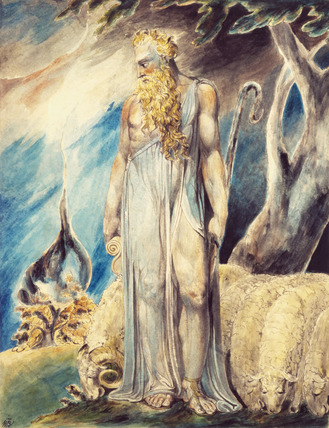
Let’s face it: the Pentateuch, which is to say the first five books of the Hebrew Bible (the Christian Old Testament), authored by Moses himself, tells a far-out story. Skipping over Genesis, the prequel to the main narrative (it’s The Hobbit, if you will, to Moses’ Lord of the Rings), we read in Exodus that the author, an adopted Egyptian prince who came to sympathize with the multiracial community of slaves known as Hebrews, encountered an entity he’d describe as flames of fire from within a bush.

This unnameable phenomenon (YHWH means “I am who I am”) seems to possess and inflame Moses: When Moses comes down from Mount Sinai after spending 40 days with YHWH, “he was not aware that his face was radiant” (Ex 34:29), and forever after, one reads, he wears a veil when he’s out in public (Ex 34:33-34). Was Moses somehow infused or injected with a substance or energy that turned his face a scarlet hue? Or did YHWH instruct him to smear his face and hands with a scarlet-colored substance before approaching the bush? Why would YHWH have done so?
We can look for clues to this mystery by asking another question: what does YHWH want? To shape the Hebrews into a nation unlike other nations, one with no king but YHWH; to reveal Its laws to the Hebrews; and, oddly enough, to instruct the Hebrews in suspiciously exacting detail on how to erect a tabernacle where It will dwell.
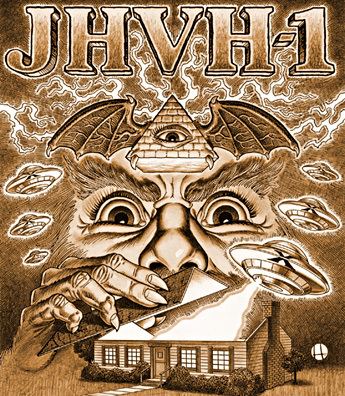
Does this take-me-to-your-leader business put anyone in mind of JHVH-1 (JEHOVAH), the evil, godlike space creature dreamed up by the parodic Church of the SubGenius? No surprise there, because in several important respects YHWH does resemble an extraterrestrial. Like the radioactive alien in the movie Repo Man, YHWH can’t be directly viewed by the Hebrews. It’s kept under lock and key in a protective containment sphere of sorts: the tabernacle. (The first written description of the tabernacle is in Exodus 33:7-10. The tabernacle would be set up outside of camp, and a “pillar of cloud” — perhaps some kind of airlock? — was visible at its door. Scholars attribute this description to the Elohist source (E), which was written about 850 BC.)
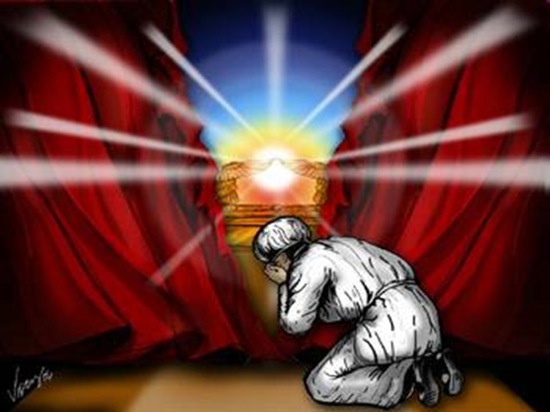
Though the Hebrews have fled into the wilderness with only a few possessions, throughout Exodus YHWH demands from them rare and specific materials for his dwelling place. First and foremost, It orders them to bring offerings of “blue, purple, and scarlet” (Ex 25:4), meaning dyes derived (in the case of blue and purple) from shellfish that swarm in the waters of the northeast Mediterranean, and (in the case of scarlet) from Dactylopius coccus, the cochineal bug, as well as from the various caterpillars and larvae that feed on cochineals.

Now, the scarlet pigment harvested from cochineals and their predators is a compound called carminic acid, which — according to chemical ecologists — functions as a protective substance. (It deters predation by other insects.) So when YHWH tells Moses that It wants Its tabernacle and Its door to be constructed of saqalat, and that furthermore It wants the ark in which It lives to be surrounded by more saqalat (Ex 26:1,36 and 27:16), It is obviously sterilizing Its environment. YHWH goes on to design the vestments of its priests, also of richly dyed cloth, and It forbids anyone “unclean” to enter the tabernacle: any priest who has become unclean through contact with other Hebrews, YHWH insists, must wash himself in scarlet.
A quick note, speculating on which microorganisms, exactly, had YHWH so worried.
According to a 2004 paper titled “The Bible and Microbiology,” when Moses instructed the Hebrews to isolate sufferers from contagious disease (e.g., Numbers 5:3, Leviticus 12:1-15:33), “this practice was not borrowed from the Egyptians, who had the most advanced overall medical know-how of the ancient world. Rather, this is an example of divine solicitude for human welfare. It preceded many hundreds of years the idea of contagion.”
Moses instructed the Hebrews to salt food — not merely as a means of food preservation, we now suspect, but because salt is an antiseptic that controls and inhibits microbial population in such foods as bread, butter, cheese, and certain vegetables. Microorganisms must have their nutrients in a water solution, and salt can inhibit bacterial growth that causes foodborne illness, such as salmonella, E. coil, and molds. Moses’ obsession with microorganisms may even explain Exodus 16:20: “Notwithstanding they hearkened not unto Moses: but some of them left of it [manna] until the morning, and it bred worms, and stank: and Moses was wroth with them.” The growth of microorganisms on the sugary medium of manna (whatever that is), scholars now suggest, may have released sulfur.
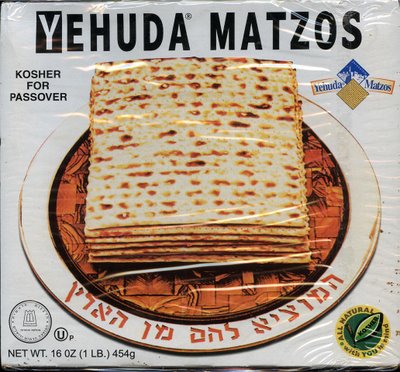
Apparently one of the Earth substances that YHWH is allergic to is yeast. We assume that the Hebrews ate unleavened bread because they were in a hurry to flee Egypt — that’s the excuse/justification given in Exodus 12:39, and that’s what we hear every year at Passover. But even before the Hebrews fled, and after, YHWH commanded them to make their bread without yeast. Check it out:
“Seven days shall ye eat unleavened bread; even the first day ye shall put away leaven out of your houses: for whosoever eateth leavened bread from the first day until the seventh day, that soul shall be cut off from Israel” (Exodus 12:15). “Ye shall eat nothing leavened; in all your habitations shall ye eat unleavened bread” (Exodus 12:20). “Unleavened bread shall be eaten seven days; and there shall no leavened bread be seen with thee, neither shall there be leaven seen with thee in all thy quarters” (Exodus 13:7).
YHWH certainly didn’t want the Hebrews getting any yeast into his meal (blood), or leaving his meal out where microorganisms could breed in it:
“Thou shalt not offer the blood of my sacrifice with leavened bread; neither shall the fat of my sacrifice remain until the morning” (Exodus 23:18, cf. 34:25). “No meat offering, which ye shall bring unto the LORD, shall be made with leaven: for ye shall burn no leaven, nor any honey, in any offering of the LORD made by fire” (Leviticus 2:11). “It shall not be baken with leaven. I have given it unto them for their portion of my offerings made by fire; it is most holy, as is the sin offering, and as the trespass offering” (Leviticus 6:17).
I’m not making this stuff up. It’s right there, in black and white, friends. If YHWH wasn’t deathly allergic to yeast, how to explain all these obsessive regulations?
UPDATE: Tom Nealon and I now believe that YHWH’s ban (Numbers 6:3) on “vinegar of wine, or vinegar of strong drink,” i.e., anything between strong drink/wine and vinegar, which is to say anything souring but not yet soured — is because a fermenting liquid like that would still contain active acetic acid bacteria. And we know how worried YHWH is about bacteria.
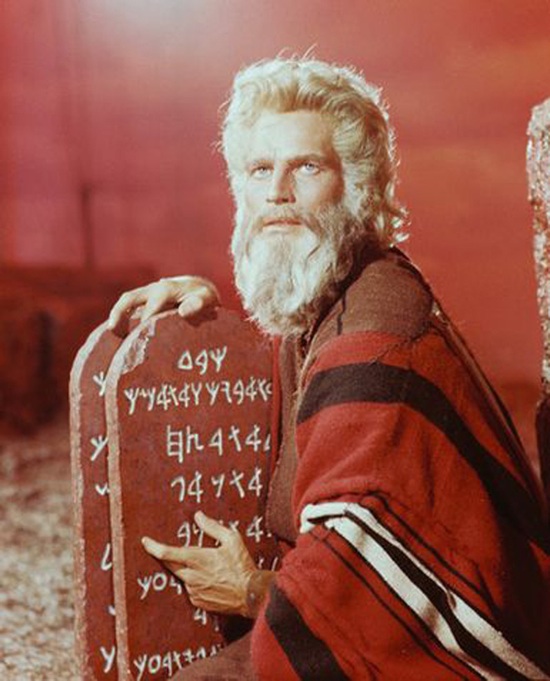
Leviticus, a book dedicated entirely to the special duties of YHWH’s priests, seems to suggest that scarlet dye was also used by the priests to infect others with what we might call the YHWH virus. In Leviticus 14, for example, we read that YHWH instructed the Levites to use a length of scarlet-dyed cord to sprinkle liquids onto the open sores of ailing Hebrews. As we shall see, the scarlet cord, which functioned something like a syringe in the hands of Moses’ priests, would become an important symbol for the Hebrews.
Scarlet, then, didn’t only function to protect YHWH from Earth’s microorganisms — which, as H.G. Wells would speculate, might be the only thing that can kill off aliens. It was also one component of an apparently potent mind-control drug, one that made subjects receptive to what the psychiatrist Robert J. Lifton calls the eight coercive methods of “thought reform,” including isolation from society at large (e.g., in a desert, for forty years), mystical manipulation (experiences that appear spontaneous but in fact were planned and orchestrated by the group or its leaders in order to demonstrate divine authority; too many of these in the Old Testament to mention); demand for purity (which we’ve just been discussing); and so forth.
Side note: according to popular mythology, one of Coca-Cola’s secret ingredients is cochineal, the scarlet dye harvested from the insect of the same name. Coca-Cola insists that this is not the case, though at present FDA regulations do not require foods containing cochineal to list it among the other ingredients.
There is a great deal more of this kind of thing in Leviticus and also in Numbers, an account of the Hebrews’ nomadic existence in the Middle East following their initial organization at Sinai. But in Numbers, YHWH finally reveals to the Hebrews his plan: they are to invade Canaan.

Why? Because Canaan, later called Phoenicia, was a land where the dyeing industry was of central importance to the economy (both names in fact mean “land of purple”); and YHWH must have desired to corner the market. Having possessed the minds and bodies of the Hebrews via his priests’ scarlet cords, YHWH organizes them into a military camp and they march from Sinai as Its conquering army. The only problem is that the Hebrews keep defying YHWH: after 39 years they still haven’t invaded Canaan, and the old guard of tabernacle insiders is dying off. In Deuteronomy, the final book of the Pentateuch, Moses makes a last-ditch series of speeches urging the Hebrews to remain faithful to YHWH, and then dies himself.

This might have been the end of the history of YHWH on Earth, were it not for the efforts of Joshua, a Hebrew strongman whose got his start standing guard outside the first, temporary tent that Moses set up for YHWH. Joshua leads the Hebrews across the Jordan into Canaan, occupies the kingdoms of Og and Sihon, and sends spies into the fortified kingdom of Jericho. At this transitional moment in the Book of Joshua (and the history of mankind), sex and death play a crucial role. Rahab, a prostitute, shelters Joshua’s spies and delivers to them the intel that the Canaanites are terrified of the Hebrews and YHWH. The spies then inform Rahab that when the Hebrews take Jericho, she can spare the lives of her family by hanging something out of her window. Remember what it was? That’s right: a scarlet cord.
Joshua and the Hebrews conquered Jericho and went on to seize control of all the hill country and the Negev, thus gaining control of the area’s dye industries. The next three major books of the Hebrew Bible — Judges, Samuel, and Kings — record Israel’s rise and fall. As the distinguished Bible scholar Richard A. Horsley points out in Bandits, Prophets, and Messiahs, Judges portrays a kind of anarchist utopia unlike any other nation (i.e., an exploitative monarchy), because it could have only one king: YHWH. Early in Samuel, however, the Israelites bring YHWH’s ark into battle against the Philistines, and it is captured.
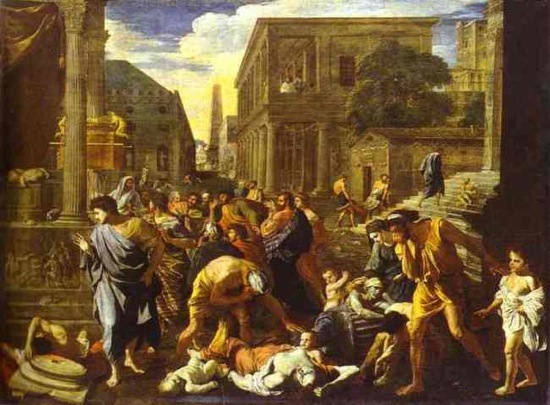
For twenty years, the ark remains outside its protective tabernacle, and diseases follow it everywhere (1 Sam 5:6). It seems correct to assume that YHWH, unprotected by saqalat, was destroyed at some point during this period. Perhaps this is what Philip K. Dick was getting at in Our Friends from Frolix 8, in which a character announces, “God is dead. They found his carcass in 2019. Floating out in space near Alpha.” Its protective container breached, its body decaying, YHWH became lethally toxic to humans. One thinks, again, of Repo Man — of Fox Harris’s unforgettable performance as a government scientist slowly being killed by the decaying alien in his car’s trunk. What did Alex Cox know?

The Hebrews, meanwhile, minds no longer clouded by whatever ego-obliterating substance they’d received via the priests’ scarlet cords, ceased to obey YHWH’s injunction that they should have no other king. Immediately after we learn of the ark’s capture, we read that Samuel, the most distinguished of Israel’s judges, was approached by a committee of Hebrews who demanded, “Now appoint a king to lead us, such as all the other nations have.”
Samuel anointed Saul, who proceeded to do what kings everywhere have always done: he built a standing army, invaded other countries, and exploited the populace. By the end of 1st and 2nd Kings, we cannot help but agree with the Hebrew prophets — who lamented that Israel had become a nation like all the other nations. PLEASE NOTE: This essay is in no way intended to be a commentary on the present-day nation of Israel.
One last note: The cochineal insect is found in Mexico and South America, not the Middle East. Also, in Biblical Hebrew, which like Phoenician is a dialect of Canaanite, the Tyrian purple-red dye extracted from the Murex brandaris, a marine gastropod also known as the spiny dye-murex, is known as shani שָׁנִי [ʃɔni], but usually translated as “scarlet.” The cochineal, in other words, may have nothing to do with YHWH. But that doesn’t mean that Moses’ YHWH wasn’t an alien, one so terrified of microorganisms that It used what tools were available in that time and place — dyes, and other substances — not only to fashion for Itself a sterile environment, but also mind-controlling chemicals with which to ensure that Its followers would remain loyal.
It’s a crackpot theory, of course. But if it were true, it would explain much that is opaque about the narrative of the Old Testament… and about modern-day America. We Americans have always enjoyed portraying ourselves as a new Israel, but these days it’s only too apparent that we’re the empire-building Israel about which Isaiah lamented. Not only that, we’re a nation of sex and death addicts, ricocheting from one extreme to another — anorexia/obesity, Puritanism/pornography, sloth/war. Why? Call it an attempt to recapture the blissfully self-annihilating highs and lows experienced thousands of years ago by the Hebrews under Moses.
Like them, we’re apparently happiest when we’re drinking somebody’s Kool-Aid.
A version of this essay was first published by Cabinet Magazine (Fall 2006, issue 23).
NB: The phrase “YHWH virus” seems to have been coined in 1989 by a ghost hunter adopting the name of Major Jack Downing. “Downing” writes:
Most or all concepts of a god are transmitted through written or spoken words, and thereafter all manifestations natural or supernatural are seen as emanating from the will of that ‘god.’ The brain has become reprogrammed by that thought-virus to perpetuate and spread the virus to others, just as real viruses do to DNA…. The most powerful Deity Virus is the YHWH virus, and all of its mutations…. The only way to cure an individual of an active Deity Virus is by Heroic Deprogramming, a process as brutal and harrowing to the patient as chemotherapy is to a cancer patient, and as with the latter example, likely as ineffectual, with the possibility of an eventual reinfection.
MORE FURSHLUGGINER THEORIES BY JOSH GLENN: TAKING THE MICKEY (series) | KLAATU YOU (series intro) | We Are Iron Man! | And We Lived Beneath the Waves | Is It A Chamber Pot? | I’d Like to Force the World to Sing | The Argonaut Folly | The Perfect Flâneur | The Twentieth Day of January | The Dark Side of Scrabble | The YHWH Virus | Boston (Stalker) Rock | The Sweetest Hangover | The Vibe of Dr. Strange | CONVOY YOUR ENTHUSIASM (series intro) | Tyger! Tyger! | Star Wars Semiotics | The Original Stooge | Fake Authenticity | Camp, Kitsch & Cheese | Stallone vs. Eros | The UNCLE Hypothesis | Icon Game | Meet the Semionauts | The Abductive Method | Semionauts at Work | Origin of the Pogo | The Black Iron Prison | Blue Krishma! | Big Mal Lives! | Schmoozitsu | You Down with VCP? | Calvin Peeing Meme | Daniel Clowes: Against Groovy | The Zine Revolution (series) | Best Adventure Novels (series) | Debating in a Vacuum (notes on the Kirk-Spock-McCoy triad) | Pluperfect PDA (series) | Double Exposure (series) | Fitting Shoes (series) | Cthulhuwatch (series) | Shocking Blocking (series) | Quatschwatch (series)
READ MORE essays by Joshua Glenn, originally published in: THE BAFFLER | BOSTON GLOBE IDEAS | BRAINIAC | CABINET | FEED | HERMENAUT | HILOBROW | HILOBROW: GENERATIONS | HILOBROW: RADIUM AGE SCIENCE FICTION | HILOBROW: SHOCKING BLOCKING | THE IDLER | IO9 | N+1 | NEW YORK TIMES BOOK REVIEW | SEMIONAUT | SLATE
